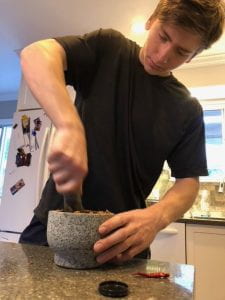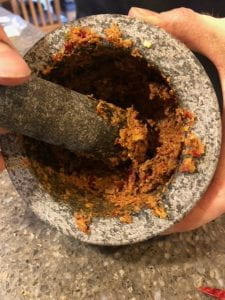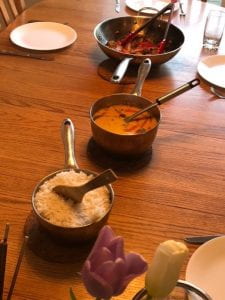It has been a long time since my last update and a fair amount has happened. At the time of making my last blog post, I had three major goals. My first goal was to learn how to make red curry paste. My second goal was to buy a mortar and pestle. My third goal was to make a better red curry. Over the past couple weeks, I accomplished all three of these goals.
I got a mortar and pestle during the first week of Spring Break. The mortar and pestle I got is made of stone. I learned from a website that a new mortar and pestle must be cleaned then seasoned using spices. I washed and scrubbed both the mortar and pestle under hot water to remove loose pieces of rock. Afterwards, I ground up raw rice and salt to season and finish cleaning the mortar and pestle.
I learned how to make red curry paste by visiting a couple websites and looking at the attached recipe. Once I had a general idea of the necessary ingredients and steps, I went shopping at TnT. The big idea of red curry paste is to grind up all the ingredients in a mortar and pestle (or food processor) turn them into a paste. Once the paste is created it is as simple as adding the paste to coconut milk. Making curry paste is difficult because there are a lot of ingredients, and it is very time consuming to make. However, the final flavour was very worthwhile. Using the red curry paste I made helped me to create a far more flavourful and complex curry. It was by far the best curry I have made, but the entire process took nearly three hours to complete.
When I was making the red curry paste, I found that I struggled using the mortar and pestle with tougher ingredients like lemon grass. I would try to grind them, but they refused to break. To solve this challenge, I used a variety of different kitchen tools. The first tool I tried was a food processor. It worked well for dicing the ingredients into smaller pieces that could be ground up easier in the mortar and pestle. I also tried using a blender. The blender worked similar to the food processor, except it didn’t spin with the same force as the food processor, so it was unable to dice the food as effectively. Overall, using a variety of tools worked best because I could treat ingredients differently. For example, galangal was very difficult to grind up, so I first put it through the food processor.
-Galangal is a root that looks similar to ginger
I have now had store bought red curry paste and homemade red curry paste, and I can confidently say that the homemade red curry paste is better. The store-bought paste is one dimensional and basic. It tastes good, but it lacks depth. In contrast, the paste I made was complex. It had layers of flavour that changed. At first it was a bit spicy then it gave way to a mix of coriander and lemongrass, with a sweet background flavour from the palm sugar. The only downside to homemade paste is the prep time. It took about an hour and a half to make the red curry paste alone.
Besides making homemade red curry paste, over the past couple weeks I have also tried to make vegetarian Pad Thai and a new dish called basil chicken. The vegetarian Pad Thai was a mix of tofu and vegetables. In my opinion, it was a failure. It was not because it was vegetarian, but because it was poorly made. Some sections would be very spicy, then other sections would have no spice at all. The first mouthful I had when eating it was so hot that it brough me to tears. Then the rest had no spice. The poor distribution of spice was because I used dried chili peppers, instead of fresh chili peppers. I also didn’t use enough sauce for the number of noodles I used. This resulted in a pad thai with weak flavour and some very spicy sections.
I can learn from this by using fresh peppers instead of dried peppers when making pad thai. Fresh peppers will help to distribute the spice throughout the dish. It will also add more flavour. I can also use more pad thai sauce to help with the flavour.
I also made a new dish called basil chicken. Basil chicken is made in a wok with bell peppers, chilis, garlic, shallots, carrots, and of course basil. Basil chicken tastes exactly like it sounds. Strong basil flavour with the touches of the other ingredients. My family and I quite enjoyed it, so I will definitely be making it again. I made a mistake while making basil chicken. I accidentally let the garlic and chili peppers burn. This added some unwanted flavours to the final product. To avoid this mistake in the future, I will keep the oven at a lower temperature and stir more frequently.
What has been your most difficult mentoring challenge so far? Why?
One of the most difficult challenges has been the length of our meeting. Most of our meetings were about 10 minutes. Short meetings are good because they are easy to schedule but they also make discussions less deep and meaningful. This has been difficult because my mentor is busy making it hard to schedule meetings. To overcome this challenge, I have had short meetings, but this results in the meetings sometimes feeling rushed.
What is working well? Why?
Something that is working well is going to meetings with questions or topics I want to learn about. It gives our meetings structure and allows my mentor to prepare before the meeting. For example, I went to a meeting and talked about making red curry paste. I brought my recipe book and we discussed some of the ways I could make it better. Meeting with the goal of learning more about red curry helped give the meeting an objective.
What could be working better? How can you make sure this happens?
I could learn more from my meetings by having more topics to discuss during the meeting. Having more topics to discuss would help me learn about more areas of Thai cooking and culture. It would build on something that is already working well. It would give the meetings more structure and would allow me to go more In-Depth with my studies. To ensure this happens, I will prepare before every meeting by sending my mentor a short list of topics I would like to discuss. I will also go to every meeting with a handful of questions about Thai cooking.
The images on the top are of me using the mortar and pestle to make the red curry paste. The images on the bottom are of me making basil chicken.






